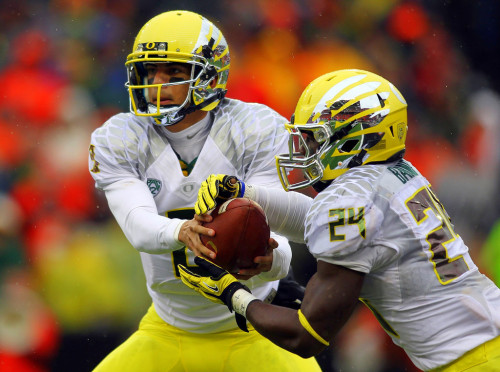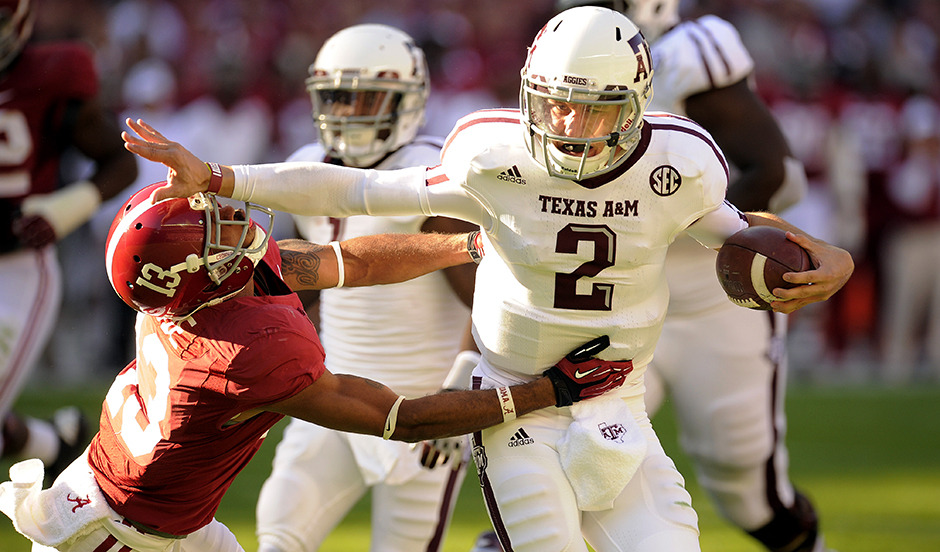Starting Point
At the start of the 2000’s and by 2005, there were a handful of successful programs running variations of the spread offense including West Virginia, Utah, and the passing extremes under the Air Raid and Run & Shoot umbrellas.
At its core, the spread offense is exactly what it says. A quarterback is usually in the shotgun with a running back offset to his left or right and four wide receivers (or three receivers and a tight end) are spread out spaced to force the defense to cover not only deep vertically but also horizontally sideline to sideline.
Nearly 10 years later and the offense has not only completely taken over the college landscape (even Kansas under Charlie Weis is changing over to a spread offense for the 2014 season) but the concept has been married to the no huddle, up tempo pace started way back when under Sam Wyche with the Cincinnati Bengals and later Ted Marchibroda and the Buffalo Bills in the NFL.
Not only are there many colleges running a spread offense system but there are a lot of nuanced variations within the overarching label as well. Teams such as Oregon, Auburn, Arizona, and Ohio State have emphasized the ground attack with zone runs and more importantly, mobile quarterbacks who can key defensive players and get yards on their feet. On the flipside are the pass happy spread Air Raids (also incorporating zone runs as of late) at California, Washington State, SMU (Run and Shoot), Texas A&M, and Texas Tech. Baylor managed to have their quarterback, Bryce Petty, finish 6th in passing yards per game while their running back finished 20th in rushing yards per game.
Pick Your Poison Defensively
As the spread has become more common, more packaged plays that combine options (example: QB reads DE for give/keep on Zone Read but also reads CB for possible bubble screen throw outside too) have started turning up, even including some routes downfield over the middle in addition to the first 3 common options.
The best offenses have defenses spinning their wheels trying to figure out whom to contain and whom to let beat them because they simply can’t cover every avenue. Arizona’s RB Ka’Deem Carey had 349 carries and averaged 5.4 yards per carry. WR Nate Phillips had 7 touchdown catches. Oregon had three different running backs combine for 379 carries but the thread of mobile quarterback Marcus Mariota allowed them to average 6.18 yards per carry (over 2,300 rushing yards total).

Tumblr
Devote yourself to stopping the run game at all costs and you can get burned through the air downfield instead. Notre Dame’s WR T.J. Jones had 70 catches and averaged 15.83 yards per catch. Missouri had two receivers combine for over 1,700 yards and 22 touchdowns. UNLV WR Devante Davis had 87 catches and averaged 14.83 yards per catch.
Marrying the Up Tempo No Huddle
Running focused teams such as Oregon and Auburn have set a dizzying pace for other teams to try and match as well. Auburn ran 1,014 plays (72 per game) while Oregon ran 973 plays (nearly 75 per game). Decades ago, a team being able to get off 65 plays a game was considered pretty impressive. Now you have teams getting off nearly ten more plays while averaging anywhere from 7 to 9 more yards (almost an additional 100 yards a game offensively).
As a result of the up tempo pace, teams have been slaughtering the offensive record books as well. Just take a look at Oregon and their ability to amass passing and rushing yards but also more importantly, look at those touchdown totals.
Oregon 2010: 3,160 yards and 31 TD with 3,739 yards and 42 TD.
Oregon 2011: 3,130 yards and 39 TD with 4,189 yards and 42 TD.
Oregon 2012: 2,888 yards and 35 TD with 4,098 yards and 48 TD.
Oregon 2013: 3,789 yards and 32 TD with 3,556 yards and 42 TD.
For comparison, one of the most dominant college football teams ever in the 1995 Nebraska Cornhuskers ran for 4,306 yards with 50 TD in 12 games but only threw for 1,721 yards and 18 TD thanks to their pro style option offense.
Along with the up tempo comes more plays and more potential to score touchdowns and score points as shown by the following programs in 2013.
Arizona: Averaged 79 plays per game and 33.5 points per game.
Clemson: Averaged 80 plays per game and 40.2 points per game.
Oklahoma State: Averaged 76 plays per game and 39.1 points per game.
Troy: Averaged 77 plays per game and 34.1 points per game.
Leveling the Playing Field
The spread offense has also helped smaller programs such as Marshall be able to compete with big name schools in both recruiting and offensively on the field as well. Marshall went 10-4 last season including an 8 point loss to Virginia Tech and an 11 point win over Maryland in their bowl game. Marshall averaged 42 points per game and a blistering 78 plays per game. Again the spread showed its versatility as they ran for almost 2,900 yards and threw for over 4,000 yards.
Another team, East Carolina, went 10-3 with wins over North Carolina and North Carolina State. They averaged 79 plays per game while running over 1,800 yards and throwing for almost 4,300. Even a decade ago, such programs would have been left in the dust trying to play catchup to the big schools by blending a pro style offense with unproductive results or struggling to lure talented athletes to compete on the field at the necessary skill positions.
Prototype Sized Quarterbacks Not Needed
With the capability of having a natural quarterback that can not only throw the ball and make decisions on the fly but also run with the ball for big yards, the sizes of the quarterbacks no longer need to be NFL ready prototypical size at 6’4″ or 6’5″. With that said, even the taller quarterbacks have proven they can be mobile as well.
B.J. Denker (Arizona): 6’3 threw for 2,516 yards and ran for 949 yards.
Nick Marshall (Auburn): 6’1 threw for 1,976 yards and ran for 1,068 yards.
Bryce Petty (Baylor): 6’3 threw for 4,200 yards and ran for 209 yards but scored 14 TD.
Tajh Boyd (Clemson): 6’1 threw for 3,851 yards and ran for 411 yards.
Jaquez Johnson (Florida Atlantic): 6’1 threw for 1,866 yards and ran for 767 yards.
James Franklin (Missouri): 6’2 threw for 2,429 yards and ran for 510 yards.
Johnny Manziel (Texas A&M): 6’1 threw for 4,114 yards and ran for 759 yards.

credit to FoxSports
The Pass Happy Success Grows Outward
Largely uniting under the Air Raid umbrella, the spread offense has allowed those programs to not only function downfield through the air but several head coaches have allowed the Air Raid to diversify and turn into more of a natural pass-centric ball control offense by using heavier doses of running the ball against their opponents when the openings have allowed it.
California (HC Sonny Dykes): 1 QB threw for 3,488 yards and 18 TD. Their RBs ran for 1,505 yards and 9 TD.
SMU (HC June Jones R&S): 1 QB threw for 3,528 yards and 21 TD. Their RBs ran for 856 yards and 7 TD. June, along with Mike Leach, remains one of the more extreme pass heavy coaches in college football today.
Texas Tech (HC Kliff Kingsbury): 2 QBs threw for 5,033 yards and 32 TD. As mentioned earlier, their RBs ran for 1,300 yards.
Washington State (HC Mike Leach): 1 QB threw for 4,597 yards and 34 TD. Their RBs ran for 875 yards and 10 TD. Leach continues to run one of the purest pass heavy spread offenses in college football.
West Virginia (HC Dana Holgorsen): 2 QBs threw for 2,724 yards and 11 TD. Their RBs ran for 1,829 yards and 17 TD.

credit to sportsworldreport.com
Spread and the Tight Ends
Due to the marriage of the no huddle up tempo approach, the spread offenses also have an advantage in being able to utilize positions such as the tight end by moving them closer to the tackles to block for the run but thanks to their athleticism, also being able to split them out into the slot and treat them as a big bodied wide receiver. TE Jace Amaro of Texas Tech’s Air Raid had 106 catches for 1352 yards and 7 TD but was effective enough as a blocker to allow Texas Tech running backs to combine for 1,300 yards and 15 TD on the ground.
Oregon had 2 tight ends combine 26 catches and 404 yards, the catches would have put them at 3rd most on the entire team. Notre Dame had Troy Niklas whom hauled in 32 catches for 498 yards. Kentucky, another Air Raid school, had their 2 tight ends combine for 21 catches and 265 yards. Auburn’s tight end had 11 catches for 154 yards.
There are no signs that the spread offense is slowing down (despite rule discussions during this offseason) and even more colleges seem to not only be transitioning to a spread offense but also combining the up tempo pace as if it were a mandatory concession needed to adopt and install the offense. We’ll see how Nick Saban feels by the start of the 2016 College Season.
Credit to XOSSports and ESPN for feature image

